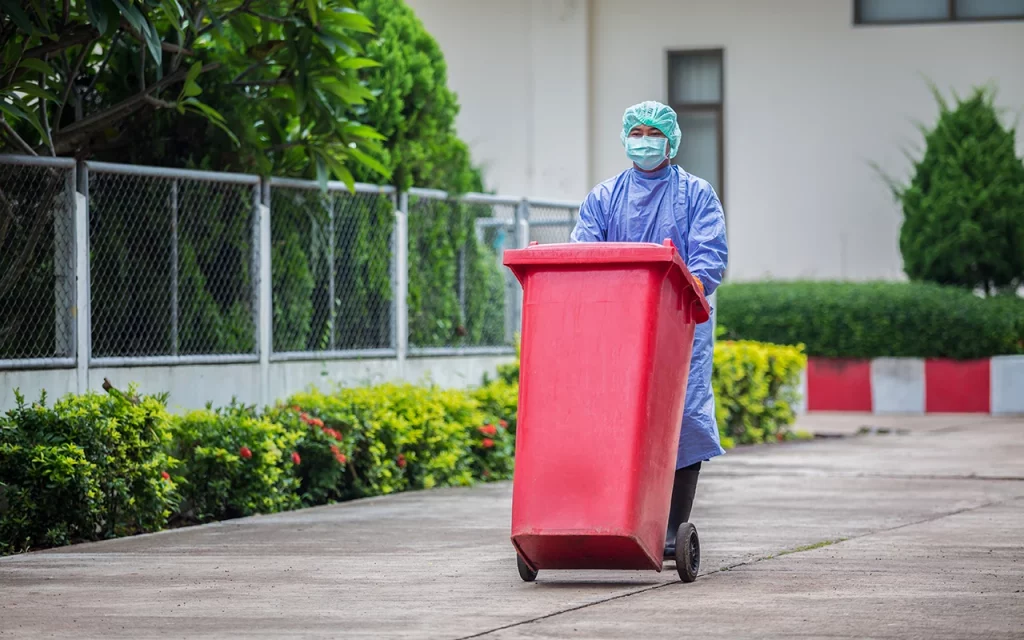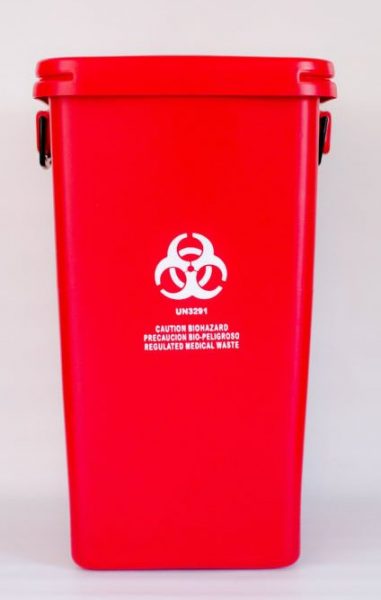Area Care: Smooth and Reliable Medical Waste Removal Near Me
Wiki Article
Stay Ahead of Regulations: Expert Suggestions on Medical Garbage Disposal
In a world where the healthcare industry is constantly developing, it is vital for medical facilities to remain in advance of guidelines when it comes to the correct disposal of clinical waste. From comprehending the different categories of clinical waste to applying the appropriate collection and partition methods, this conversation will certainly supply workable ideas and useful insights to help facilities remain ahead of laws in the ever-changing landscape of clinical waste disposal.Recognizing Medical Waste Categories
Recognizing medical waste groups is essential for proper disposal and management in health care facilities. Clinical waste refers to any type of waste generated by medical care activities that might present a risk to public wellness or the atmosphere. It is vital to categorize clinical waste accurately to guarantee its risk-free handling, disposal, transportation, and therapy.There are several groups of clinical waste that health care centers require to be familiar with. One of the most common classifications consist of transmittable waste, pathological waste, sharps waste, pharmaceutical waste, and chemical waste. Each classification has details guidelines and laws for its proper administration and disposal.
Pathological waste refers to human cells, body organs, or body components that need unique handling and disposal. Drug waste makes up ended, unused, or contaminated drugs that need cautious handling and disposal.
Staying Up-To-Date With Regulatory Modifications
Staying current with regulatory adjustments is important for health care facilities to guarantee compliance and proper management of medical garbage disposal. medical waste removal. With regulations constantly evolving, it is vital for health care facilities to remain updated to prevent penalties, fines, and potential harm to the setting and public health and wellnessTo stay ahead of regulatory changes, medical care facilities should develop a system for surveillance and monitoring updates. This can be done by registering for regulative newsletters, attending workshops and seminars, and actively taking part in sector associations. In addition, facilities ought to designate an employee or team liable for staying informed and sharing info to appropriate stakeholders.
Normal communication with governing firms is additionally essential. Healthcare centers should develop partnerships with regional, state, and government agencies to guarantee they recognize any modifications in policies that may affect their waste monitoring practices. This can be done with normal conferences, engagement in public remark periods, and proactive involvement with regulative companies.
Furthermore, health care facilities need to consider partnering with waste monitoring companies that concentrate on clinical waste disposal (medical waste disposal services with WasteX). These companies are commonly well-versed in the newest regulations and can supply advice and support to make certain compliance
Applying Proper Collection and Segregation Techniques
To successfully manage clinical garbage disposal, health care centers have to establish proper collection and partition approaches based on governing guidelines. Implementing these approaches makes certain the safe handling and disposal of potentially hazardous materials, shields the setting, and minimizes the danger of injuries and infections to health care workers and the public.
Appropriate collection and segregation approaches involve making use of designated containers and identifying systems. Healthcare centers should supply clearly classified containers for various kinds of medical waste, such as sharps, contagious waste, pharmaceutical waste, and non-hazardous waste. These containers must be color-coded and plainly significant to prevent confusion and advertise very easy identification.
Furthermore, medical care facilities need to educate their personnel on the proper treatments for gathering and setting apart clinical waste. This includes enlightening them on the various types of waste, the suitable containers to use, and the significance of following guidelines and guidelines. Regular training sessions and refresher course courses must be performed to ensure that personnel continue to be up-to-date on ideal practices.
In addition, healthcare centers need to develop a system for normal collection and disposal of medical waste. This might entail partnering with accredited waste administration firms that concentrate on medical waste disposal. These business will certainly ensure that the accumulated waste is transferred and thrown away in conformity with regulative requirements.
Choosing the Right Disposal Techniques

Incineration is just one of the most reliable and common techniques for dealing with specific types of medical waste, such as pathological waste and sharps. It includes the regulated burning of waste at high temperatures, lowering it to ash. Incineration can release damaging toxins right into the air and add to air pollution.
Various other disposal approaches include chemical treatment, microwave treatment, and landfilling. Chemical therapy involves making use of chemicals to sanitize and reduce the effects of the waste. Microwave treatment utilizes microwave power to heat and sanitize the waste. Landfilling includes hiding the waste in check here an assigned landfill area (medical waste disposal services with WasteX). Landfilling needs to be the last resort due to the potential threat of contamination to dirt and groundwater.
Making Certain Compliance Via Documents and Training
After carefully considering the ideal disposal methods for medical waste, medical care centers need to make sure compliance with policies and minimize ecological effect by carrying out effective documentation and training treatments. This step is essential in keeping a lasting and safe setting for both medical care employees and the public.
Health care employees that handle medical waste needs to get appropriate training on waste segregation, dealing with, and disposal procedures. By providing comprehensive training, health care centers can equip their staff to make informed decisions and minimize the danger of incorrect waste disposal.
Final Thought
In conclusion, remaining ahead of regulations in clinical garbage disposal is crucial for health care facilities. medical waste removal services. Comprehending the different classifications of clinical waste, staying updated with governing adjustments, applying proper collection and partition approaches, selecting the appropriate disposal approaches, and making sure compliance via documents and training are all vital steps. By complying with these standards, healthcare organizations can properly manage and get rid of of medical waste in a safe and responsible fashionFrom understanding the different groups of medical waste to implementing the ideal collection and partition approaches, this discussion will supply workable ideas and valuable understandings to help centers stay ahead of laws in the ever-changing landscape of clinical waste disposal. - medical waste disposal services with WasteX
The most common categories include infectious waste, pathological waste, sharps waste, pharmaceutical waste, and chemical waste. Healthcare facilities must give plainly classified containers for various types of clinical waste, such as sharps, site web infectious waste, pharmaceutical waste, and non-hazardous waste. Health care centers ought to establish a detailed system to advice tape and track all facets of clinical waste disposal, including types of waste generated, amounts, and disposal approaches used. Medical care workers who handle clinical waste needs to get suitable training on waste partition, dealing with, and disposal treatments.
Report this wiki page